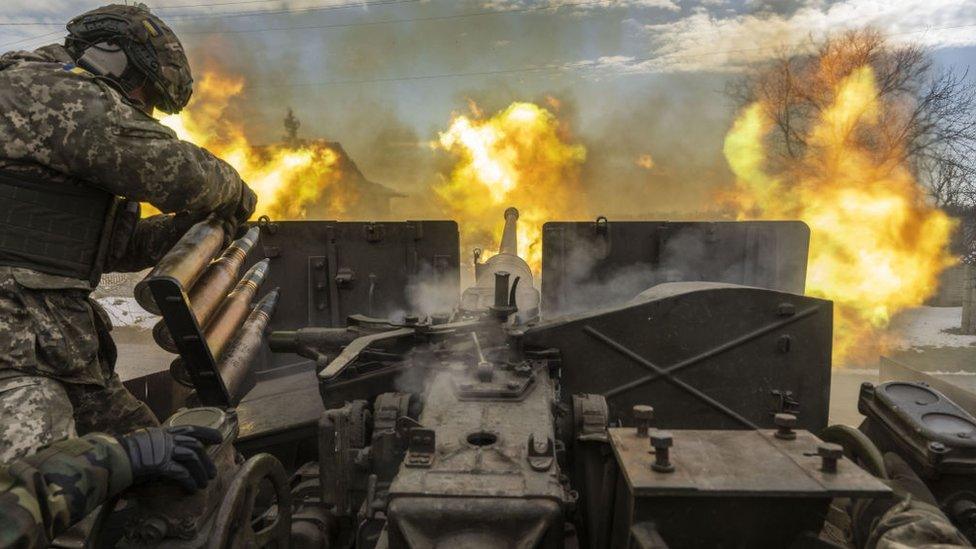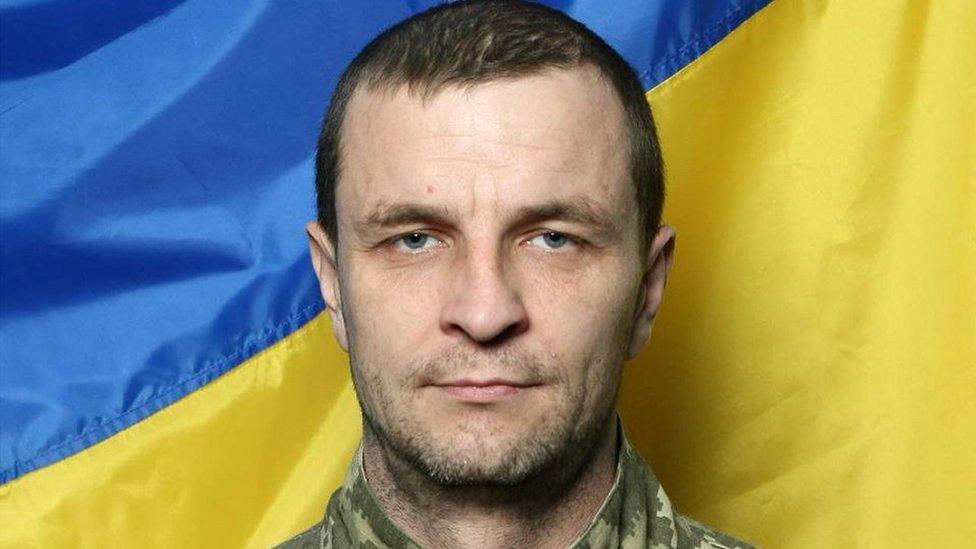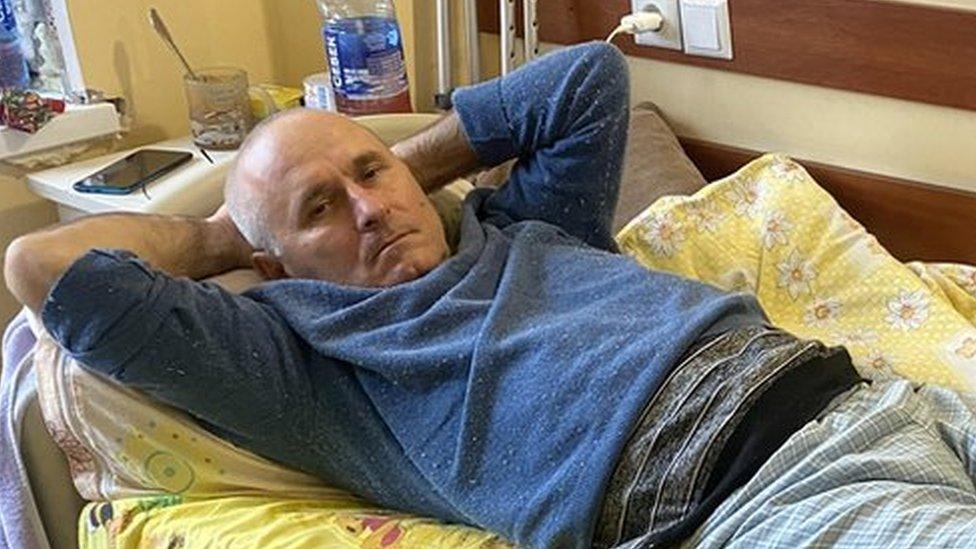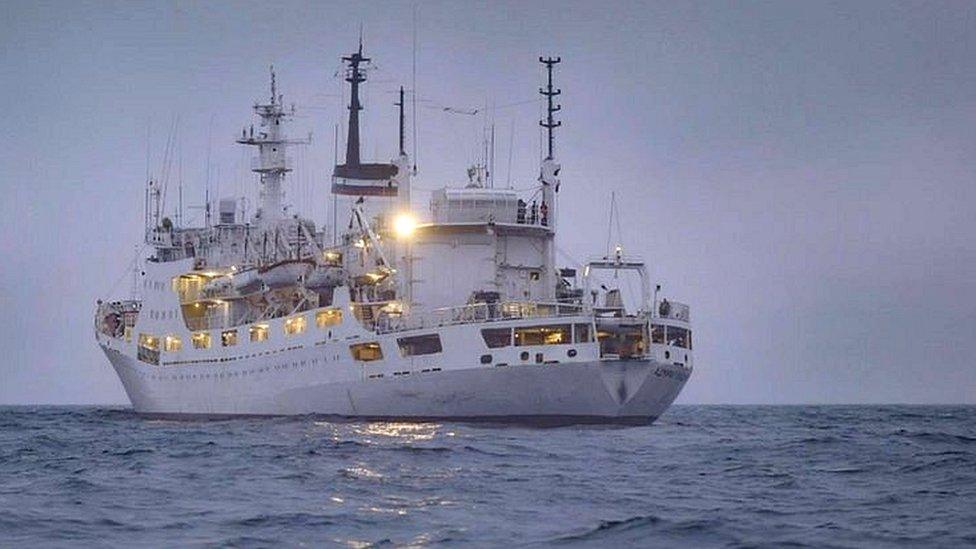Ukraine war: Bakhmut defender remembered by comrades
- Published

Pavel Kuzin was killed in Bakhmut amid brutal fighting around the eastern Ukrainian city
Staff sergeant Pavel Kuzin took his position at the machine gun - the only soldier still able to fight. Everyone else in his troop lay dead or injured.
Suffering from shell-shock and with one arm bandaged, the 37-year-old fired at the waves of Russian soldiers trying to storm his position. They didn't even try to take cover, but simply walked towards him across the open field.
It was clear Pavel wouldn't be able to hold the position for long, but he needed to buy time for a rescue team to arrive. His final action in life was to ensure his wounded comrades got to safety.
The Ukrainian military says Bakhmut is now the scene of many "unprecedentedly bloody" battles like this, where they now have to repel up to 50 attacks on their positions every day. Russia has concentrated massive forces in this area, and their brutal strategy of launching human wave attacks helps them to advance slowly - but at a very high cost.
Pavel was in charge of a forward observation group that consisted of six Ukrainian soldiers. On 17 February, shortly after the start of their watch, they came under heavy fire. A tank began hammering their position.
Unlike relentless mortar rounds, the tank's aiming was chillingly accurate. Shells were landing a few metres from their trenches. Two soldiers were wounded and Pavel told them to go into a dugout. A combat medic went down to tend to their injuries and prepare them for an evacuation. Moments later, the wooden shelter was directly hit by a shell.
"There was a bright flash," one of the wounded soldiers with a callsign Tsygan told the BBC. "I was thrown onto the logs with such force that it nearly crushed me. I couldn't understand whether I was dead or alive. Someone was shouting, it seemed the sound was coming from 100m away."
I couldn't understand whether I was dead or alive
It was Pavel's voice who was checking on them. The other soldier was half-buried under dirt and logs. He was dead.
Tsygan could barely move and Pavel had to drag him up over the splintered logs that blocked the way. It was painfully slow to move Tsygan just a few metres away into a nearby trench. When the shelling paused briefly, Pavel went back trying to find others.
Two minesweepers arrived to clear the logs and find the bodies. But yet another shell hit the dug out, killing one of the men and injuring the other. The tank kept firing.
At that moment, Russian troops started storming their position. Pavel called for a support group to evacuate the wounded and rushed back to his Browning machine gun to stop the Russian infantry.
The 206th Battalion in which Pavel served had fought in the southern Kherson and north-eastern Kharkiv regions. But the battles over Bakhmut were very different from what they had seen before.
"The intensity of fighting to break through our positions was shocking," says Mykola Hlabets, platoon commander. "Sometimes, [Russian soldiers] would get as close as 20 metres from us, crawling and moving under a treeline or across an open field. This is where we had our first gunfights at such proximity."
"They would just stand and walk towards our positions without any cover. We wiped out one group after another, but they kept coming."
Hlabets described them as a suicide squad. Others call them cannon fodder.

Ukrainians are trying to fight off Russia's human wave attacks - similar to tactics used during World War One
A number of videos have been shared on telegram channels recently where newly mobilized Russian soldiers appealed to President Vladimir Putin and the authorities to stop what they called "illegal orders" to send them "to be slaughtered".
Last month mobilised soldiers from Belgorod posted a video saying that they were sent for an assault mission without proper training. After suffering heavy losses, they said they refused to carry out their orders.
Often these poorly trained soldiers are reportedly forced to keep pushing forward. The assault group Storm of the 5th Brigade of the Russian army said in a video appeal that they couldn't leave their position because of zagryad otryad, or blocking troops - detachments that open fire at their own men who try to retreat.
These wave attacks are similar to World War One tactics, when troops charged the enemy and engaged in close combat. And despite their lack of training and experience, sending newly recruited soldiers to such assaults are bringing some results for Russia, albeit at a very high cost.
Ukrainians expose their positions when they open fire to stop those attacks. That allows Russian artillery to identify the target and destroy it, as happened with Pavel's post.
Also, soldiers at forward positions run out of ammunition while trying to repel numerous wave attacks. They then become an easy target.

That was the risk Pavel knew he faced as he rushed to his Browning machine gun. But as long as he kept firing, his wounded brothers-in-arms had a chance to be rescued.
Tsygan was bleeding in the trench where Pavel had left him. Shrapnel had smashed his pelvis. Another piece had gone through his thigh, and a third had hit his abdomen, "turning the internal organs upside down", he said. He was barely conscious.
"I didn't see much, it was all white," he said. "I lay on the snowy ground for two hours and I didn't feel cold or anything."
Next to him was another wounded soldier. The rescue team on an armoured personnel carrier hastily picked them up as shelling resumed. They didn't even have time to close the hatch, Tsygan says.
By that time, Pavel's machine gun had fallen silent. He died from a head wound: a piece of shrapnel had pierced his helmet.
Commanders of the 206th battalion decided to send a group to retrieve the bodies of Pavel and the other soldiers.
The next day in the evening, three groups of two soldiers each set off to bring the bodies back.
"The plan looked good on paper, but things quickly went wrong," junior sergeant Vasyl Palamarchuk, who was in the lead group, remembers. They got lost and nearly ran into Russian positions in the dark. When they got close to the dugout, Russians spotted them and opened fire from a tank.

Pavel Kuzin died holding off Russian attackers so his wounded fellow soldiers could be evacuated
Russian tanks and artillery had continuously shelled that post in those days, but the Ukrainian big guns had largely stayed quiet. The reason was a massive shortage of shells.
"Once we counted that the Russians had fired up to 60 shells a day, whereas we could allow only two," Palamarchuk explains. "They destroyed trees and everything else and you had no place to hide."
Ukraine is struggling to find ammunition for its Soviet-era artillery. Getting shells for weapons donated by Ukraine's western partners has its own limits. As the secretary general of the Nato military alliance, Jens Stoltenberg, said recently: "The current rate of Ukraine's ammunition expenditure is many times higher than our current rate of production."
Palamarchuk's group eventually picked up Pavel's body just a few hours before Russian troops seized the area. Heavy snow turned into a freezing rain. After numerous breaks on the way back, crawling through craters left by shells, they finally arrived. The whole operation over just a kilometre's distance lasted for six hours.
It was past midnight but the entire battalion gathered at the evacuation point to pay their respects to Pavel, who is survived by his daughter and wife.
"It was a huge loss for our unit," Palamarchuk says. "He saved two people but died himself."
Related topics
- Published15 April 2023

- Published11 April 2023

- Published19 April 2023
